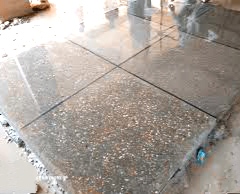Table of Contents
What is Granolithic Flooring?
Granolithic flooring is the same as cement-concrete flooring except for the top layer. This layer is finished with a granite surface, a cement-concrete made from specially selected aggregates.
See the below image of Granolithic Flooring.

The granite surface makes the floor hard, wear-resistant and durable. The granite concrete layer should be at least 13 mm thick.
Coarse aggregate should be extracted from hard fine granite, basalt, limestone and quartzite.
Detailed Description of Granolithic Flooring
Granolithic flooring is made of cement and fine aggregates.This type of flooring also called as granolithic paving. It has an appearance similar to concrete and is used to provide a durable surface where texture and appearance are not usually important. It is usually laid as a screed.
Traditional screed have low quantity of cement while granolithic screed have high quantity of cement. A screed is a type of floor covering that is placed on components to create a flat surface on which the “floor” rests. The screed can also be exposed to provide a durable surface.
How to Make Granolithic Flooring?
There are two methods of granolithic floor construction. First is monolithic method and second is prefabricated method.
In a monolithic installation, workers use an amount of 1 part marble chips to 3 parts cement to pour the aggregate mixture onto the slabs that define the required floor area. This mixture requires him to rest for 48 hours before polishing. Workers apply a layer of protective sealer after pre-treating the surface with an acid solution so that the sealer adheres properly. These sealers come in a wide variety of colors and finishes.
In precast construction, granite tiles are pre-formed at the factory, and workers simply press them firmly into the ground using a hydraulic press.
Pros and Cons of Granolithic Flooring
Granolithic flooring can withstand heavy loads, making them suitable for warehouses, factories, and other workplaces where heavy items are stored, manufactured, or used. The relatively cheap materials and labor required make it budget-friendly.
These types of floors can cause some problems while solving others. For example, noise problems arise when sound tends to bounce off of hard concrete surfaces. Floors can also be difficult to clean and feel cold all the time.
